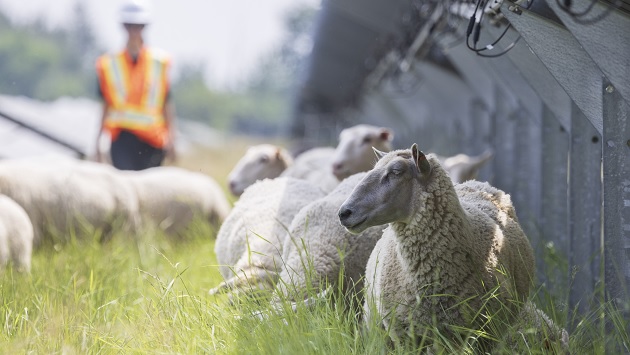Enbridge recruits hungry ovines to manage vegetation at Sarnia Solar Project
NORTHAMPTON, MA / ACCESSWIRE / September 11, 2024 / We can't say they're baaaaaaaack . . . because they just arrived for the first time.
What we can say is this. "Ewe" might not believe what you're seeing this summer in a drive past Enbridge's Sarnia Solar Project, one of the largest solar energy facilities in Canada.
With help from local sheep farmers Brenten and Meika Pelleboer, we've embarked on a novel approach to vegetation management on an 85-acre section of the Sarnia Solar property.
As of mid-July, the Pelleboers' flock of about 270 Rideau Arcott sheep, plus trusty livestock guardian dogs Ivy and Ned, have moved right in.
It "cud" be the beginning of a beautiful friendship.
"When we're working with our sheep on the solar site, we often find them lying underneath the panels happily chewing their cud, which is a sign of a happy sheep," says Brenten, adding the panels provide the sheep with a cool, dry place whenever shelter is needed.
Deploying grazing sheep, or goats, to help manage vegetation has been gaining popularity across North America for several years. For a solar facility like Sarnia Solar, there are a litany of potential benefits that the wooly summer interns are sure to provide.
"It's a pilot program but we're confident there will be a range of positive outcomes," says Enbridge Saria Solar Project operations supervisor Ian Robertson. "Debris from conventional mowers can damage panels and there's risk from motorized equipment igniting dry vegetation. The sheep are also very effective - because they graze right in close to the infrastructure."
Enbridge will also be watching for potential benefits to the overall biodiversity of the lands, which cover 1,100 acres, house about 1.3 million solar energy panels and generate 80 MW of electricity. The fluffy, four-legged mowers could eliminate the need for pesticides, and also support the growth of native flowering plants like clover, which are preferred by insects, including bees.
Enbridge began operations at Sarnia Solar in 2008. We've taken a thoughtful approach when considering the ecosystem across the property, which at one time was farmland.
Along the way, we've worked with the Return the Landscape organization to preserve endangered plants and restore woodlands and wetlands. We even saw the introduction of five full honeybee colonies - an estimated total of 400,000 bees - six years ago as part of an ongoing pollinator program.
Our hope is that happily foraging sheep will now take their place in a closely interconnected landscape.
It could be the bee's knees.
Or "shear" genius.
Or . . . a lamb dunk.

View additional multimedia and more ESG storytelling from Enbridge on 3blmedia.com.
Contact Info:
Spokesperson: Enbridge
Website: https://www.3blmedia.com/profiles/enbridge
Email: [email protected]
SOURCE: Enbridge




